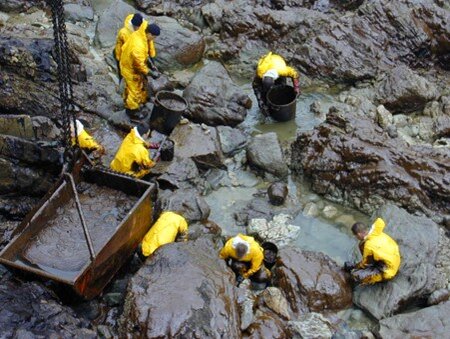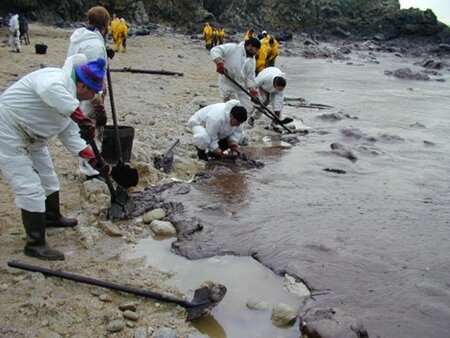ERIKA, West of France, 1999
12 December 1999


Incident
The Maltese tanker ERIKA, carrying some 31,000 tonnes of heavy fuel oil as cargo, broke in two in a severe storm in the Bay of Biscay on 12th December 1999, 60 miles from the coast of Brittany. All members of the crew were rescued by the French maritime rescue services. Some 19,800 tonnes of oil were spilled. The bow sank on 12th December and the stern on the following day.
Under strong winds and currents, oil began to strand around the mouth of the River Loire on Christmas Day 1999. Intermittent oiling occurred subsequently over some 400km of shoreline between Finistère and Charente-Maritime, including offshore islands, notably Belle Ile. The duration of the oil at sea led to the formation of significant water-in-oil emulsions, with increased volume and viscosity.
Response
The French Naval Command in Brest took charge of the response operations at sea in accordance with the French National Contingency Plan. Response vessels were mobilised but attempts at skimming met ultimately with little success owing to the poor weather and widespread fragmentation of the oil. Estimates suggest less than 3% of the total spill volume was collected during the response operations at sea.
Between 190,000 and 200,000 tonnes of oily waste was collected from shorelines by commune, department and regional workers, supported by the fire & rescue service, private contractors and others. Temporary reception facilities were established in car parks and stretches of land close to beaches, mainly by building earth or sand bunds or in plastic lined holes. Most of the clean-up was completed by November 2001. Ultimately, the French oil company Total agreed to receive all the wastes at their Donges refinery, where adequate storage was available. Insufficient segregation meant a mixture of oil, sand, debris, seaweed, protective clothing, damaged booms and other response equipment, such as like scrapers, buckets and spades, required additional sorting before disposal could proceed.
Operations to pump out oil remaining in the sunken sections of ERIKA began once the weather improved in June 2000 and were completed successfully within three months. Some 10,000 tonnes of oil were recovered during the main pumping operations.
The magnitude of the spill and the length of coastline affected resulted in a large number of claims for compensation for clean-up activities and pollution damage, prmarily important coastal fisheries, maricultural (oysters and mussels), salt production areas and tourism. The P&I insurer for ERIKA paid claims in accordance with the 1992 Civil Liability Convention, following which the 1992 International Oil Pollution Compensation Fund paid up to a total of €129.7 million. Additional expenditure was incurred by Total for waste treatment, recovery of oil from the wreck and other costs.
In 2008 a lengthy court process against the shipowner, the ship management company, the classification society (RINA) and the charterer (Total SA.) found all four parties criminally liable for the offense of causing pollution and liable for civil damages. During this process, the court found that while the parties could in theory benefit from provisions under the 1992 CLC, they had acted recklessly and so could not rely on the provision and were therefore liable.
A global settlement between the 1992 IOPC Fund, the casualty’s P&I Club, RINA and Total SA was reached to settle court cases outstanding between the parties.
ITOPF involvement
ITOPF staff were mobilised to site by the casualty’s P&I insurer and the IOPC Fund. Staff remained on site for over 10 months and provided advice on many aspects of the response. On-site assessment of potential damages to fisheries, salt production and other economic resources required regular site visits and meeting attendance. During the course of the incident ITOPF worked also in close co-operation with the Joint Claims Office established in Lorient. ITOPF’s involvement in the technical assessment of claims, on behalf of the P&I insurer and the 1992 Fund, continued for many years.
Selected Bibliography
- The ERIKA oil spill: environmental contamination and effects in the Bay of Biscay(2004). Special issue of Aquatic Living Resources, Volume 17, Number 3, July-September 2004. EDP Sciences
- Le Guerroue, P., Poupon, E., Merlin, F.X., Cariou, G. (2003). Recovery of sunken and buried oil in coastal water during the Erika spill. Proceedings of the International Oil Spill Conference 2003, Vancouver, Canada, 6-11 April 2003 (CD ROM). American Petroleum Institute, Washington DC, USA
- Ragot, R., Poncet, F., Laruelle, F., Tintilier, F. (2003). Results of a three year monitoring programme on the natural recovery of vegetation after the Erika oil spill: Lessons for adapting response techniques. Proceedings of the International Oil Spill Conference 2003, Vancouver, Canada, 6-11 April 2003 (CD ROM). American Petroleum Institute, Washington DC, USA
- Laruelle, F., Kerambrun, L. (2001). Erika oil spill: some innovations in the French shoreline response and beach cleanup methods. Proceedings of the twenty-fourth Arctic and Marine Oilspill Program (AMOP) technical seminar (including 18th TSOCS and 3rd PHYTO), Edmonton, Canada, 12-14 June 2001, 671-678. Environment Canada, Ottawa, Canada
- Couvreur, J.-F., Scherrer, P. (2001). Treatment of waste from the Erika spill. Proceedings of the International Oil Spill Conference 2001, Tampa, Florida, 26-29 March 2001 (CD ROM). American Petroleum Institute, Washington DC, USA
- LeDrean-Quenec'hdu, S., Jacques, J-P., Lamy, A. (2001). The Erika oil spill: The bird rescue response. Proceedings of the International Oil Spill Conference 2001, Tampa, Florida, 26-29 March 2001 (CD ROM). American Petroleum Institute, Washington DC, USA
- Peigne, G., Cabioc'h, F. (2001). Offshore operations following the Erika oil spill. Proceedings of the International Oil Spill Conference 2001, Tampa, Florida, 26-29 March 2001 (CD ROM). American Petroleum Institute, Washington DC, USA
Links
Categories: France, Oil, Oil Tanker, Europe, Disposal
